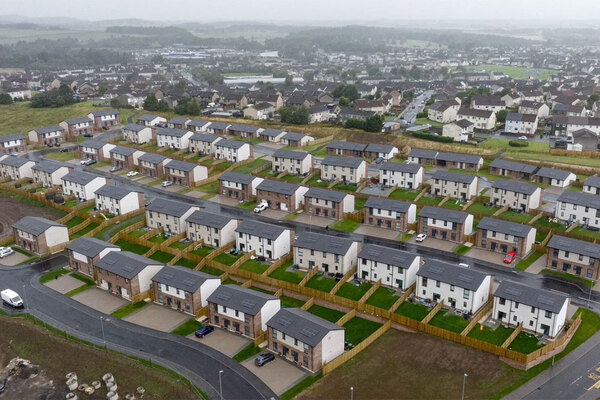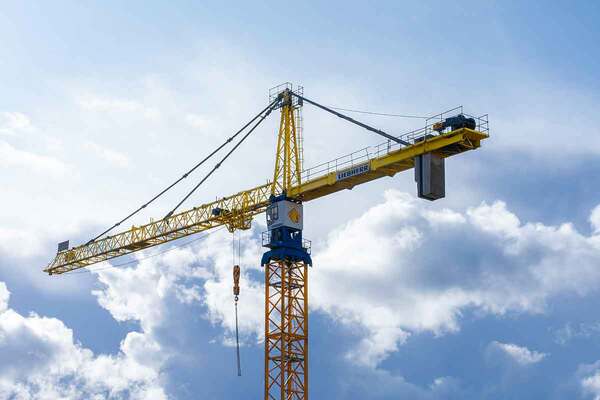Council housebuilding: back with a vengeance
If the government’s housing ambitions are to be met, councils will have to step up to the plate. Nathaniel Barker finds out how town halls are going back to the future. Illustration by Matthew Land
Under Harold Macmillan as housing minister in 1953, councils completed a staggering 198,210 homes in England – that is one every two minutes, 40 seconds.
Two years before this astounding feat, Mr Macmillan’s Conservatives were elected on the back of a pledge to build 300,000 new homes annually. This autumn is the second anniversary of ex-chancellor Philip Hammond’s promise to get to the same speed of delivery by the mid-2020s.
At least until recently, ministers knew that even getting close to this ambitious target will be achieved only if council housebuilding makes a serious comeback.
A year ago, this led to what some commentators have described as the most significant housing policy of recent times: the removal of the borrowing cap on the Housing Revenue Account, giving councils the freedom to borrow to fund their ambitions to build at scale for the first time in a generation. Twelve months on, there is much interest in what will emerge from this ambition in the future.
That is why Inside Housing has decided to examine exactly what town halls have been delivering on housing – and what they expect to do next.
Using the Freedom of Information Act, we gathered information from 240 councils across England – around three-quarters of the country’s lower-tier or unitary authorities.
Our extensive data shows what they built over the past five years and how they built it, whether through the Housing Revenue Account (HRA), a housing company or otherwise. Then, we looked at what they are plotting over the next five.
Scottish and Welsh councils have been excluded from this research because of the different policy environments – but it should be acknowledged that the former have been developing at scale for some time, while the latter are also enacting a major housebuilding revival.
Among the 240 councils, 131 have directly delivered new housing since 2014/15. Together, using all mechanisms, they have completed 18,999 net additions, meaning the total added to the country’s stock (essentially new builds plus conversions minus demolitions).
It should be noted here that we have not counted acquisitions. Although purchases, particularly Right to Buy buy-backs, form a significant part of many councils’ strategies, we are focused here on the delivery of additional new housing – anything that contributes towards the magic 300,000 figure.
The biggest builder by some distance was Birmingham City Council, with 2,207 homes completed over the period analysed, all through Birmingham Municipal Housing Trust (BMHT) – an enterprise established in 2009 as a means of delivering new HRA housing. Of these, 416 were for social rent, 893 were for affordable rent and 898 were for market sale.
Jane Trethewey, assistant director for housing development at the council, says the high level of for-sale homes has been instrumental in allowing BMHT to sustain high levels of activity: “Councils are mainly expected to fund development through the HRA, but HRA capital is already very stretched, covering all management and maintenance costs, so there isn’t a lot to dip into for new build. We’ve been able to use the profit from building market sale to plug that funding gap.”
However, she adds that the market sale element has brought other benefits in its own right, allowing the council to use its extensive market intelligence to build new homes on sites left untouched by the risk-averse traditional house builders.
“That has allowed us to challenge market assumptions and put in homes where otherwise they would not be,” she explains. And, she adds, it helps the council to deliver whole multi-tenure schemes.
Impressively, BMHT has risen to become the biggest developer in Birmingham. For Ms Trethewey, it is a good example of the rewards that a little risk can bring.
“It varies from council to council what the appetite for risk is, and that does make a big difference,” she says. “Building homes for sale clearly brings with it a degree of risk, and in Birmingham the city was up for that risk. I think the case is very well proven now and the council is comfortable with it and there’s no question about it continuing.”
Councils with the top 50 biggest development plans over the next five years (2019/20 - 2023/24)
| Council | Total | HRA | Housing company | General fund | Notes |
|---|---|---|---|---|---|
| Havering | 5,438 | 3,000 | 2,438 | 0 | Driven by "12 estates" regeneration programme |
| Barking and Dagenham | 3,290 | 19 | 3,088 | 183 | Largely through BeFirst housing company |
| Croydon | 2,928 | 4 | 2,916 | 8 | 500 a year through Brick by Brick |
| Newham | 2,656 | 1,056 | 1,600 | 0 | |
| Sheffield | 2,409 | 1,112 | 1,297 | 0 | |
| Hackney | 2,121 | 1,421 | 0 | 700 | |
| Ealing | 2,037 | 536 | 1,501 | 0 | |
| Enfield | 1,924 | 1,026 | 0 | 898 | |
| Southwark | 1,846 | 1,846 | 0 | 0 | |
| Hammersmith and Fulham | 1,800 | 1,800 | 0 | 0 | |
| Hounslow | 1,549 | 885 | 664 | 0 | |
| Norwich | 1,525 | 1,250 | 275 | 0 | |
| Leeds | 1,500 | 1,500 | establishing company | not yet known | |
| Gateshead | 1,491 | 167 | 866 | 458 | |
| Wolverhampton | 1,388 | 529 | 859 | 0 | |
| Cornwall | 1,320 | 320 | 1,000 | 0 | |
| Westminster | 1,244 | 541 | 311 | 392 | |
| Greenwich | 1,203 | 750 | 226 | 227 | |
| Newcastle upon Tyne | 1,200 | 250 | 600 | 350 | |
| Birmingham | 1,167 | 1167 | 0 | 0 | |
| Southampton | 1,000 | 1,000 | not yet known | not yet known | |
| Stockport | 1,000 | 500 | 500 | not yet known | |
| Haringey | 1,000 | 1,000 | 0 | 0 | |
| Windsor and Maidenhead | 963 | 0 | 113 | 850 | |
| King's Lynn and West Norfolk | 912 | 0 | 0 | 912 | Some may be delivered through a housing company |
| Barnet | 879 | 373 | 506 | 0 | |
| Islington | 875 | 625 | 0 | 250 | |
| Crawley | 849 | 758 | 0 | 91 | |
| Lewisham | 828 | 300 | 281 | 247 | |
| Cambridge | 814 | 521 | 293 | 0 | |
| Blackpool | 769 | 269 | 500 | 0 | |
| Bournemouth | 701 | 195 | 428 | 78 | |
| Milton Keynes | 700 | 500 | 200 | 0 | |
| Welwyn Hatfield | 688 | 247 | 150 | 291 | |
| Stoke-on-Trent | 680 | 400 | 280 | 0 | |
| Nottingham | 671 | 468 | 203 | 0 | |
| Medway | 648 | 48 | 600 | 0 | Also planning more HRA developments with numbers not yet known |
| Harrow | 639 | 639 | 0 | 0 | |
| Wandsworth | 625 | 625 | 0 | 0 | Based on 1,000 over 8 years |
| Harrogate | 600 | 500 | 100 | 0 | |
| Rotherham | 600 | 600 | 0 | 0 | |
| York | 600 | 600 | 0 | Not yet known | |
| Kensington and Chelsea | 600 | 600 | Still deciding the mix of delivery mechanisms | ||
| South Norfolk | 598 | 0 | 598 | 0 | |
| Winchester | 550 | 500 | 50 | 0 | |
| Oxford | 548 | 0 | 548 | 0 | |
| Dacorum | 506 | 300 | 206 | 0 | |
| Bexley | 500 | 0 | 500 | 0 | |
| Darlington | 500 | 500 | 0 | 0 | |
| Northampton | 500 | 500 | 0 | 0 |
Source: Reponses from local authorities to requests made under the Freedom of Information Act
Manchester City Council came in second with 1,396 homes delivered, including 930 through joint ventures. Similarly, third-placed Newcastle has delivered 820 homes, including 356 through its Scotswood ‘DevCo’ (development company) joint venture with Keepmoat and Barratt. King’s Lynn and West Norfolk came out top among non-stock-retaining councils with 267 homes completed, 230 of which were for market sale. Wakefield and Eastleigh also deserve honourable mentions, having delivered 152 and 144 homes respectively through housing companies.
It is worth pointing out the sheer variety of mechanisms for development. “What we are seeing is a diversification of the delivery model,” says Steve Partridge, director at Savills Housing Consultancy. “It’s very much horses for courses, people going with what works for them.”
For instance, while some councils have kept it firmly within the HRA, others – such as Stockport – have been delivering through subsidiary housing associations set up by their ALMOs. Runnymede has funded a huge 223 homes through its general fund. Hammersmith & Fulham has chosen to channel its HRA capital into housing associations as the means for delivering affordable homes in the borough.
All this is particularly evident in the rise of housing companies. A report produced this summer for the Royal Town Planning Institute by Janice Morphet and Ben Clifford of the Bartlett School of Planning at UCL found that 78% of authorities now have some form of housing company.
“There are so many ways this is being done,” Ms Morphet observes. “Each have their own pathways and are on their own voyage of finding out about what they can do. And it’s evolving – if you looked again in 2020 you would see even more complexity.”
Tenure of council homes delivered 2014/15 – 2018/19
| Source | Temporary accommodation | Social rent | Affordable rent | Affordable ownership* | Market rent | Market sale |
|---|---|---|---|---|---|---|
| HRA | 41 | 3,688 | 7,298 | 702 | 0 | 1,550 |
| Housing company | 0 | 114 | 571 | 311 | 197 | 1,222 |
| General Fund | 98 | 41 | 139 | 24 | 62 | 319 |
| Totals | 139 | 3,843 | 8,008 | 1,037 | 259 | 3,091 |
Note: Not all councils provided tenure breakdowns
*Includes shared ownership and Rent to Buy
Source: Freedom of Information Act requests obtained from local authorities
The HRA is very much the dominant delivery mechanism according to our research, accounting for 73% of homes completed. Housing companies, including joint ventures and homes retained by ALMOs, made up 22%, with 5% otherwise delivered using general fund investment.
Tenure breakdowns are presented below – note that not all councils were able to provide these.
Counting net figures does not flatter every authority, or necessarily reflect their activity in this area. For example, Nottingham City Council – including through its ALMO Nottingham City Homes – has built 496 homes over the period analysed but has demolished 807. This includes the redevelopment of five ageing tower blocks at Lenton Green into 142 new homes, and is a useful reminder that housing delivery is more than just a numbers game.
Looking ahead to the next five years, things get very exciting.
Together, the councils we analysed expect to build 78,651 homes in total. Clearly this is an estimate – some councils based their figures on schemes with planning permission, others provided an indication of their ambitions that might not be fully realised. However, it is likely to be an underestimate if anything, with 29 councils expressing a desire to get building without yet knowing exact numbers.
Top 50 biggest council builders 2014/15 - 2015/19
| Council | Total homes completed |
|---|---|
| Birmingham | 2,207 |
| Manchester | 1,396 |
| Newcastle upon Tyne | 820 |
| Sheffield | 727 |
| Hackney | 644 |
| Leeds | 562 |
| Stockport | 485 |
| Hull | 425 |
| Doncaster | 415 |
| Hounslow | 397 |
| Ealing | 379 |
| Cambridge | 356 |
| Northumberland | 329 |
| Crawley | 326 |
| Woking | 300 |
| Islington | 290 |
| Bournemouth | 281 |
| King's Lynn and West Norfolk | 267 |
| Derby | 262 |
| Wigan | 250 |
| Sandwell | 244 |
| Dudley | 240 |
| North Tyneside | 236 |
| Runnymede | 235 |
| Cheshire West and Chester | 230 |
| Wolverhampton | 222 |
| Gateshead | 218 |
| Newark and Sherwood | 211 |
| Dacorum | 210 |
| Winchester | 202 |
| Portsmouth | 200 |
| Darlington | 187 |
| Mansfield | 182 |
| North Kesteven | 178 |
| Corby | 158 |
| Havering | 158 |
| Wiltshire | 158 |
| Wakefield | 152 |
| Eastleigh | 144 |
| Ipswich | 144 |
| Central Bedfordshire | 135 |
| Barking and Dagenham | 132 |
| Cornwall | 127 |
| Newham | 117 |
| Norwich | 117 |
| Wealden | 116 |
| Oxford | 115 |
| Uttlesford | 114 |
| East Riding of Yorkshire | 107 |
| South Norfolk | 107 |
Source: Freedom of Information Act requests obtained from local authorities
Town halls told us they have earmarked £8.4bn to fund these programmes – although again, that is likely to be a drastic underestimate, with many councils as yet unsure of budgets.
Tellingly, 21 councils that have not built in the previous five years have outlined plans to start in the next five, with combined plans for 3,120 new homes. A dozen more are either setting up a housing company or actively considering doing so.
There are councils that previously transferred their housing stock seeking to reopen HRAs. Liverpool and Peterborough councils have already announced their intentions to do this, and others are understood to be planning similar moves.
“We get people asking us about this all the time,” says Mr Partridge. “Our general advice is that there’s a technical accounting aspect here which you have to get comfortable with. We may think it’s simply a case of opening an HRA and then building lots of lovely social housing, but there are legal challenges. Of course, the big upsides are around being able to bid for grant.”
Interestingly, only 54% of these new homes are anticipated to be delivered within the HRA, while 36% are slated for housing companies. That is driven largely by the huge ambitions of councils like Barking & Dagenham and Croydon, which are plotting 3,088 and 2,916 homes through their respective vehicles.
Tenure breakdown of homes built by councils through the HRA 2014/15 - 2018/19
| Council | Temporary accommodation | Social rent | Affordable rent | Affordable home ownership | Market sale | Notes |
|---|---|---|---|---|---|---|
| Birmingham | 0 | 416 | 893 | 0 | 898 | Also building homes through InReach housing company - figures not provided |
| Manchester | No tenure breakdown provided for 60 HRA and 1,336 housing company homes. Includes PFI and joint ventures. | |||||
| Newcastle upon Tyne | 0 | 0 | 460 | 0 | 0 | Includes joint venture |
| Sheffield | 0 | 30 | 74 | 0 | 0 | Includes joint venture |
| Hackney | 0 | 168 | 0 | 55 | 421 | |
| Leeds | 0 | 420 | 134 | 0 | 0 | Most social rent of any council |
| Stockport | 0 | 0 | 102 | 74 | Part-funded through borrowing from the General Fund | |
| Hull | 0 | 0 | 425 | 0 | 0 | |
| Doncaster | 0 | No tenure breakdown for 415 HRA homes | ||||
| Hounslow | 0 | 0 | 321 | 76 | 0 | |
| Ealing | 0 | 0 | 239 | 46 | 50 | |
| Cambridge | 0 | 254 | 0 | 45 | 57 | |
| Northumberland | 0 | 191 | 62 | 0 | 0 | No breakdown for 5 General Fund homes |
| Crawley | 0 | 76 | 159 | 26 | 0 | |
| Woking | 0 | 238 | 0 | 0 | 0 | |
| Islington | 0 | 238 | 0 | 23 | 0 | |
| Bournemouth | 0 | 0 | 82 | 22 | 0 | No breakdown for 177 housing company |
| King's Lynn and West Norfolk | 0 | 0 | 0 | 0 | 0 | |
| Derby | 0 | 0 | 184 | 20 | 0 | 58 housing company homes delivered through ALMO, no breakdown given |
| Wigan | 0 | 1 | 249 | 0 | 0 | |
| Sandwell | 0 | 0 | 244 | 0 | ||
| Dudley | 0 | No tenure breakdown | ||||
| North Tyneside | 0 | 47 | 38 | 0 | 0 | Tenure breakdowns do not include 126 through PFI |
| Runnymede | 0 | 0 | 12 | 0 | 0 | No breakdown for 223 General Fund homes |
| Cheshire West and Chester | 0 | 0 | 210 | 20 | 0 | |
| Wolverhampton | 0 | 5 | 123 | 0 | 80 | |
| Gateshead | 0 | 0 | 0 | 0 | All through joint venture | |
| Newark and Sherwood | 0 | 0 | 186 | 0 | 0 | Housing company homes delivered through ALMO |
| Dacorum | 41 | 169 | 0 | 0 | 0 | |
| Winchester | 0 | 0 | 182 | 20 | 0 | |
| Portsmouth | 0 | 0 | 200 | 0 | 0 | |
| Darlington | 0 | 4 | 183 | 0 | 0 | |
| Mansfield | 0 | 5 | 161 | 16 | ||
| North Kesteven | 0 | 0 | 145 | 0 | 0 | |
| Corby | 0 | 0 | 158 | 0 | ||
| Havering | 0 | 0 | 105 | 53 | 0 | |
| Wiltshire | 0 | 0 | 117 | 41 | ||
| Wakefield | 0 | 0 | 0 | 0 | 0 | |
| Eastleigh | 0 | 0 | 0 | 0 | 0 | No breakdown for 144 housing company homes |
| Ipswich | 0 | 144 | 0 | 0 | ||
| Central Bedfordshire | 0 | 96 | 8 | 31 | 0 | |
| Barking and Dagenham | 0 | 23 | 18 | 34 | 0 | No breakdown for 57 housing company homes |
| Cornwall | 0 | 61 | 0 | 0 | 0 | |
| Newham | 0 | 10 | 42 | 0 | 0 | |
| Norwich | 0 | 69 | 0 | 0 | 0 | |
| Wealden | 0 | 0 | 116 | 0 | 0 | |
| Oxford | 0 | 51 | 42 | 0 | 0 | |
| Uttlesford | 0 | 0 | 114 | 0 | 0 | |
| East Riding of Yorkshire | 0 | 0 | 107 | 0 | ||
| South Norfolk | 0 | 0 | 0 | 0 | 0 |
Source: Freedom of Information Act requests obtained from local authorities
Ms Morphet notes that “it takes about two years from the company being set up to actually getting on site” and thus expects to see the scores of new companies recently established to really get going towards the end of 2020.
Nine of the 10 councils with the loftiest housebuilding ambitions captured by our data are in the capital. Darren Rodwell, leader of Barking & Dagenham Council and executive member for housing at London Councils, is not surprised.
“It’s fair to say that London is pulsing and we are bursting at the seams when it comes to the need for good-quality affordable homes,” he says. “I think we’ll be the new, larger entity of London housebuilding moving forwards.”
He believes that the “perfect storm” currently facing housing associations and the private sector – a heady combination of housing market slowdown and huge fire safety costs – will see local authorities step up to the plate “to deliver for the great need in our communities”.
Notably, Birmingham anticipates the net delivery of 1,167 new homes over the next five years – making it unusual in stepping down its development. There may be a cautionary tale within this case study.
Tenure breakdown of homes built by councils through housing companies 2014/15 - 2018/19
| Council | Social rent | Affordable rent | Affordable home ownership | Market rent | Market sale |
|---|---|---|---|---|---|
| Birmingham | 0 | 0 | 0 | 0 | 0 |
| Manchester | |||||
| Newcastle upon Tyne | 0 | 29 | 29 | 0 | 298 |
| Sheffield | 30 | 31 | 24 | 42 | 496 |
| Hackney | 0 | 0 | 0 | 0 | 0 |
| Leeds | 0 | 0 | 0 | 0 | 0 |
| Stockport | 4 | 203 | 102 | 0 | 0 |
| Hull | 0 | 0 | 0 | 0 | 0 |
| Doncaster | 0 | 0 | 0 | 0 | 0 |
| Hounslow | 0 | 0 | 0 | 0 | 0 |
| Ealing | 0 | 0 | 0 | 0 | 44 |
| Cambridge | 0 | 0 | 0 | 0 | 0 |
| Northumberland | 0 | 71 | 0 | 0 | 0 |
| Crawley | 0 | 0 | 0 | 0 | 0 |
| Woking | 0 | 62 | 0 | 0 | 0 |
| Islington | 0 | 0 | 0 | 0 | 0 |
| Bournemouth | |||||
| King's Lynn and West Norfolk | 0 | 0 | 0 | 0 | 0 |
| Derby | |||||
| Wigan | 0 | 0 | 0 | 0 | 0 |
| Sandwell | 0 | 0 | 0 | 0 | 0 |
| Dudley | |||||
| North Tyneside | 0 | 13 | 0 | 0 | 12 |
| Runnymede | 0 | 0 | 0 | 0 | 0 |
| Cheshire West and Chester | 0 | 0 | 0 | 0 | 0 |
| Wolverhampton | 0 | 2 | 0 | 0 | 12 |
| Gateshead | 0 | 39 | 33 | 65 | 81 |
| Newark and Sherwood | 0 | 10 | 0 | 0 | 15 |
| Dacorum | 0 | 0 | 0 | 0 | 0 |
| Winchester | 0 | 0 | 0 | 0 | 0 |
| Portsmouth | 0 | 0 | 0 | 0 | 0 |
| Darlington | 0 | 0 | 0 | 0 | 0 |
| Mansfield | 0 | 0 | 0 | 0 | 0 |
| North Kesteven | 0 | 6 | 0 | 27 | 0 |
| Corby | 0 | 0 | 0 | 0 | 0 |
| Havering | 0 | 0 | 0 | 0 | 0 |
| Wiltshire | 0 | 0 | 0 | 0 | 0 |
| Wakefield | 28 | 0 | 21 | 0 | 103 |
| Eastleigh | |||||
| Ipswich | 0 | 0 | 0 | 0 | 0 |
| Central Bedfordshire | 0 | 0 | 0 | 0 | 0 |
| Barking and Dagenham | |||||
| Cornwall | 12 | 0 | 13 | 41 | 0 |
| Newham | 0 | 0 | 65 | 0 | 0 |
| Norwich | 18 | 0 | 2 | 7 | 21 |
| Wealden | 0 | 0 | 0 | 0 | 0 |
| Oxford | 22 | 0 | 0 | 0 | 0 |
| Uttlesford | 0 | 0 | 0 | 0 | 0 |
| East Riding of Yorkshire | 0 | 0 | 0 | 0 | 0 |
| South Norfolk | 0 | 19 | 0 | 0 | 88 |
Source: Freedom of Information Act requests obtained from local authorities
“All the low-hanging fruit has been picked; there are no easy sites anymore and that is going to be a challenge,” explains Ms Trethewey.
That means the council is now turning to trickier projects – such as regenerations that will require extensive community consultation, as well as looking at building at higher densities and trying out modular development.
“Unlike a developer we have more of a commitment to the community, so we have to be very careful and mindful of their priorities.”
The low-hanging fruit conundrum is a “key theme”, Mr Partridge remarks, noting that more complex schemes also come with higher costs. And bear in mind all the other enormous bills on the horizon, from building standards and fire safety to energy efficiency and the zero-carbon agenda.
That brings us to the next big question: whether councils’ ambitions can be delivered. Mr Rodwell describes himself as “optimistically concerned”.
Tenure breakdown of homes built by councils through general fund 2014/15 - 2018/19
| Council | Temporary accommodation | Social rent | Affordable rent | Affordable home ownership | Market ren | Market sale | Notes |
|---|---|---|---|---|---|---|---|
| Birmingham | 0 | 0 | 0 | 0 | 0 | 0 | Also building homes through InReach housing company - figures not provided |
| Manchester | No tenure breakdown provided for 60 HRA and 1,336 housing company homes. Includes PFI and joint ventures. | ||||||
| Newcastle upon Tyne | 0 | 0 | 4 | 0 | 0 | 0 | Includes joint venture |
| Sheffield | 0 | 0 | 0 | 0 | 0 | 0 | Includes joint venture |
| Hackney | 0 | 0 | 0 | 0 | 0 | 0 | |
| Leeds | 8 | 0 | 0 | 0 | 0 | 0 | Most social rent of any council |
| Stockport | 0 | 0 | 0 | 0 | 0 | 0 | Part-funded through borrowing from the General Fund |
| Hull | 0 | 0 | 0 | 0 | 0 | 0 | |
| Doncaster | 0 | 0 | 0 | 0 | 0 | 0 | No tenure breakdown for 415 HRA homes |
| Hounslow | 0 | 0 | 0 | 0 | 0 | 0 | |
| Ealing | 0 | 0 | 0 | 0 | 0 | 0 | |
| Cambridge | 0 | 0 | 0 | 0 | 0 | 0 | |
| Northumberland | No breakdown for 5 General Fund homes | ||||||
| Crawley | 0 | 0 | 65 | 0 | 0 | 0 | |
| Woking | 0 | 0 | 0 | 0 | 0 | 0 | |
| Islington | 0 | 0 | 0 | 0 | 0 | 29 | |
| Bournemouth | 0 | 0 | 0 | 0 | 0 | 0 | No breakdown for 177 housing company |
| King's Lynn and West Norfolk | 0 | 27 | 0 | 10 | 0 | 230 | |
| Derby | 0 | 0 | 0 | 0 | 0 | 0 | 58 housing company homes delivered through ALMO, no breakdown given |
| Wigan | 0 | 0 | 0 | 0 | 0 | 0 | |
| Sandwell | 0 | 0 | 0 | 0 | 0 | 0 | |
| Dudley | No tenure breakdown | ||||||
| North Tyneside | 0 | 0 | 0 | 0 | 0 | 0 | Tenure breakdowns do not include 126 through PFI |
| Runnymede | No breakdown for 223 General Fund homes | ||||||
| Cheshire West and Chester | 0 | 0 | 0 | 0 | 0 | 0 | |
| Wolverhampton | 0 | 0 | 0 | 0 | 0 | 0 | |
| Gateshead | 0 | 0 | 0 | 0 | 0 | 0 | All through joint venture |
| Newark and Sherwood | 0 | 0 | 0 | 0 | 0 | 0 | Housing company homes delivered through ALMO |
| Dacorum | 0 | 0 | 0 | 0 | 0 | 0 | |
| Winchester | 0 | 0 | 0 | 0 | 0 | 0 | |
| Portsmouth | 0 | 0 | 0 | 0 | 0 | 0 | |
| Darlington | 0 | 0 | 0 | 0 | 0 | 0 | |
| Mansfield | 0 | 0 | 0 | 0 | 0 | 0 | |
| North Kesteven | 0 | 0 | 0 | 0 | 0 | 0 | |
| Corby | 0 | 0 | 0 | 0 | 0 | 0 | |
| Havering | 0 | 0 | 0 | 0 | 0 | 0 | |
| Wiltshire | 0 | 0 | 0 | 0 | 0 | 0 | |
| Wakefield | 0 | 0 | 0 | 0 | 0 | 0 | |
| Eastleigh | 0 | 0 | 0 | 0 | 0 | 0 | No breakdown for 144 housing company homes |
| Ipswich | 0 | 0 | 0 | 0 | 0 | 0 | |
| Central Bedfordshire | 0 | 0 | 0 | 0 | 0 | 0 | |
| Barking and Dagenham | 0 | 0 | 0 | 0 | 0 | 0 | No breakdown for 57 housing company homes |
| Cornwall | 0 | 0 | 0 | 0 | 0 | 0 | |
| Newham | 0 | 0 | 0 | 0 | 0 | 0 | |
| Norwich | 0 | 0 | 0 | 0 | 0 | 0 | |
| Wealden | 0 | 0 | 0 | 0 | 0 | 0 | |
| Oxford | 0 | 0 | 0 | 0 | 0 | 0 | |
| Uttlesford | 0 | 0 | 0 | 0 | 0 | 0 | |
| East Riding of Yorkshire | 0 | 0 | 0 | 0 | 0 | 0 | |
| South Norfolk | 0 | 0 | 0 | 0 | 0 | 0 |
“I’m optimistic because I think the will is there; I’m concerned because I think the national politics is not helping our authority programmes,” he says.
He cites the Becontree Estate in his borough, where 27,000 council homes were built in 12 years under the Addison Act a century ago. “If they could do it 100 years ago using horse and cart, the question is, why can’t we?” he challenges.
In today’s money, building the Becontree would cost around £18bn – double the government’s entire affordable housing grant programme for 2016 to 2021. For Mr Rodwell, therein lies the issue.
“One thing we always need to remember is: who’s going to do the building?” Mr Partridge asks. “There are issues around capacity obviously, and around skills and expertise. We’ll need to see greater collaboration, with authorities, housing associations and developers all working together in order to share risk and reward.
“Whenever you talk about new build it’s always worth reminding people that there is a lot of work to do and not enough people to do it.”
That hard work starts now.
Inside Housing Development Summit
New for 2019, Inside Housing is bringing together a carefully curated group of 150 key partners to agree how to support housing development. This is not a conference. It is a business meeting of decision-makers.
Gathering together local authorities, housing associations, developers, funders and advisers, this Chatham House event is focused on making connections, finding solutions and doing business.
Places for each stakeholder group are limited to ensure a balanced mix of participants, and to ensure you leave with the relationships and leads you need.
The event takes place on 11 and 12 November at Woodlands Event Centre, Bedfordshire.
Click here to register your interest
Seize the opportunity to:
- Pitch investment opportunities in your area
- Go on an exclusive guided development site study tour
- Access key experts and their network
- Attend interactive round table discussions with colleagues from across the development ecosystem
- Connect with potential housing delivery partners
Key topics include:
- Land
- Funding
- Skills
- Working with SMEs
- Partnerships













